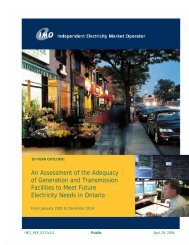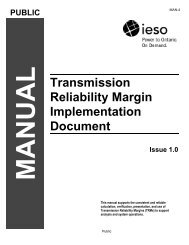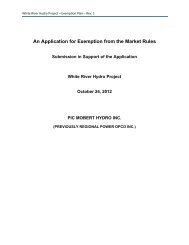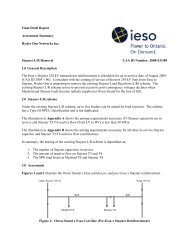Dispatch Technical Working Group Summary (Updated) - IESO
Dispatch Technical Working Group Summary (Updated) - IESO
Dispatch Technical Working Group Summary (Updated) - IESO
You also want an ePaper? Increase the reach of your titles
YUMPU automatically turns print PDFs into web optimized ePapers that Google loves.
<strong>Dispatch</strong> <strong>Technical</strong> <strong>Working</strong> <strong>Group</strong><br />
<strong>Summary</strong><br />
<strong>Dispatch</strong> <strong>Technical</strong> <strong>Working</strong> <strong>Group</strong> (SE-91)<br />
September 5, 2012
Overview<br />
• Review of <strong>Dispatch</strong> <strong>Technical</strong> <strong>Working</strong> <strong>Group</strong><br />
design decisions<br />
– <strong>Dispatch</strong> Data and <strong>Technical</strong> Limitations<br />
– <strong>Dispatch</strong> Scheduling Process<br />
– Compliance Deadbands<br />
– Market Schedules<br />
– Congestion Management Settlement Credits<br />
– Tie-breaking<br />
– Forecast reports<br />
• DTWG Design <strong>Summary</strong> Document and Market<br />
Manuals 2
<strong>Dispatch</strong> <strong>Technical</strong> <strong>Working</strong> <strong>Group</strong><br />
• DTWG was formed to address questions arising<br />
from the <strong>Dispatch</strong>ing Variable Generation<br />
Resources discussion paper relating to:<br />
– <strong>Dispatch</strong> data<br />
• Price/Quantity pairs<br />
• Ramp rates<br />
• <strong>Technical</strong> limitations<br />
– <strong>Dispatch</strong> mechanics<br />
– Compliance to dispatch instructions<br />
– Congestion Management Settlement Credits (CMSC)<br />
• Additionally, the issue of tie-breaking was<br />
introduced to address impacts of floor prices<br />
3
<strong>Dispatch</strong> Data Requirements
<strong>Dispatch</strong> Data - Offers<br />
Are two price/quantity pairs sufficient to capture price<br />
sensitivity over the entire operating range of a variable<br />
generator?<br />
• Wind generators indicated that they have a technical preference<br />
against shutting down turbines, which occurs below approximately<br />
10% of available output<br />
– a minimum of two laminations would be required to reflect price sensitivity for<br />
this technical preference<br />
• Solar generators did not express a price sensitivity over their<br />
operating range<br />
• To allow for the integration of forecast data, PQ pairs should reflect<br />
price sensitivity up to the available capacity of the generator<br />
Decision: Variable generators will have the ability to submit up to 20<br />
price/quantity pairs<br />
5
<strong>Dispatch</strong> Data – Ramp Rates<br />
Do wind and solar generators require the ability to submit ramp<br />
rates and break points? Should the <strong>IESO</strong> assume a common<br />
ramp rate for variable generators as dictated by fuel type?<br />
• In Ontario, ramp rates vary from facility to facility<br />
• Solar generators indicated that ramp rates can vary at a facility<br />
depending on output level<br />
• No need to restrict variable generators ability to submit ramp rates<br />
and break points<br />
Decision: Variable generators will have the ability to submit up to 5<br />
ramp rates (up and down) and break points<br />
6
<strong>Dispatch</strong> Data – <strong>Technical</strong> Limitations<br />
What technical limitations exist for wind and solar generators<br />
that must be respected by the dispatch algorithm in order to<br />
produce a viable dispatch instruction that can be followed?<br />
• The only technical limitation identified by DTWG members was<br />
the preference of wind generators to minimize the need to shut<br />
down individual turbines<br />
• Wind generators indicated that this could be achieved through<br />
dispatch data<br />
Decision: No new technical limitations will need to be registered for<br />
variable generators<br />
7
<strong>Dispatch</strong> Scheduling Process
Forecast<br />
(Hourly, 5minute)<br />
<strong>Dispatch</strong><br />
Scheduling<br />
Forecast to <strong>Dispatch</strong><br />
Submission of dispatch data will be as follows:<br />
• Market participant (MP) will be responsible for<br />
submitting offers to reflect price sensitivity<br />
• Offer will be comprised of up to 20 price-quantity<br />
pairs ($/MWh) and up to 5 up/down ramp rates<br />
(MW/min).<br />
• In the Day-Ahead Commitment Process (DACP) and<br />
pre-dispatch, <strong>IESO</strong> will economically schedule to<br />
respect the lesser of:<br />
• the offered quantity;<br />
• the hourly forecast; or,<br />
• any submitted derates.<br />
• In real-time, the <strong>IESO</strong> will use the 5-minute forecast as<br />
well as submitted offers and derates.<br />
9
MIO<br />
<strong>Dispatch</strong> Data<br />
DSO DAOS<br />
Predispatch<br />
DACP<br />
Forecast to <strong>Dispatch</strong> (cont’d)<br />
• <strong>Dispatch</strong> data used as input to <strong>Dispatch</strong><br />
Scheduling Optimizer (DSO) for Multi-<br />
Interval Optimization (MIO), DACP and<br />
pre-dispatch solutions.<br />
• Pre-dispatch algorithm and DACP will<br />
recognize forecast value as a constraint<br />
(in both Market Schedule and<br />
Constrained Schedule) and variable<br />
generators are scheduled identically to<br />
other dispatchable resources.<br />
• In real-time, variable generators will<br />
differ from other dispatchable resources<br />
in both the initialization of the MIO<br />
dispatch algorithm as well as the<br />
content of the dispatch instructions.<br />
10
• 5-minute forecast will:<br />
5 Minute Forecast<br />
Background<br />
– Be available for each dispatchable variable generator<br />
– Be updated every 5-minutes<br />
– Span a rolling 24 intervals (2 hour time horizon)<br />
• <strong>Dispatch</strong> Scheduling Optimizer (DSO) will<br />
utilize the 5- minute forecast as an input for both<br />
real-time sequences for dispatch and pricing<br />
purposes
Constrained<br />
sequence for<br />
Interval 3<br />
commences<br />
Unconstrained<br />
sequence for<br />
Interval 3<br />
commences<br />
12:05<br />
12:10<br />
5-minute Forecast<br />
Constrained vs. Unconstrained<br />
For Interval 3:<br />
• The constrained sequence will utilize the most recent 5<br />
minute forecast received in advance of 12:05 to<br />
determine dispatch<br />
• The unconstrained sequence will utilize the most<br />
recent 5 minute forecast received in advance of 12:15 to<br />
determine market schedule<br />
12:15<br />
12:20<br />
(INT 2) (INT 3) (INT 4) (INT 5)<br />
12:25<br />
12
5-minute Forecast<br />
Reporting<br />
• Market participant facility-specific reports will<br />
be made available hourly and will:<br />
– Be confidential to the market participant; and<br />
– Include the 12 interval forecasts utilized by the<br />
unconstrained sequence for the previous hour<br />
• After the fact, public reports will use an average<br />
of the most-recent 5-minute forecast for each<br />
interval to determine an hourly value
<strong>Dispatch</strong><br />
Instruction<br />
(Message Exchange)<br />
5-minute Forecast<br />
MIO<br />
<strong>Dispatch</strong><br />
Advisories<br />
(Web Reports)<br />
Multi-Interval Optimization:<br />
Use of 5-Minute Forecast<br />
• MIO optimizes 5 critical<br />
intervals selected from up to 11<br />
future intervals.<br />
• MIO produces a dispatch<br />
instruction for the next interval<br />
and dispatch advisories for an<br />
additional 4 critical intervals.<br />
• For the dispatch interval, the<br />
variable generators most recent<br />
5-minute forecast is the basis<br />
for determining dispatch<br />
instructions.<br />
• Advisories will use the most<br />
recent 5-minute forecast values<br />
for those intervals<br />
14
If an economic or security<br />
constraint exists on the system, the<br />
variable generator may be<br />
required to change its output.<br />
• The dispatch instruction will be sent<br />
to the variable generator and the<br />
new target output will be based on<br />
the constrained solution (limited by<br />
5-minute forecast quantity).<br />
• <strong>Dispatch</strong> instruction will include a<br />
new piece of information<br />
(“Obligation Indicator”) which will<br />
tell the Market Participant that the<br />
instruction is mandatory<br />
• MIO advisories will also include<br />
Obligation Indicator<br />
<strong>Dispatch</strong> Obligation: Mandatory<br />
MIO<br />
<strong>Dispatch</strong> Instruction<br />
VG is uneconomic or security constrained<br />
Target Output<br />
Constrained<br />
Solution<br />
<strong>Dispatch</strong><br />
Instruction is<br />
Mandatory<br />
15
• The dispatch instruction must be<br />
followed to mitigate the economic or<br />
security constraint.<br />
• Market participant must comply<br />
with a mandatory dispatch<br />
instruction unless doing so would<br />
endanger the safety of any person,<br />
damage any equipment, or violate<br />
any applicable law.<br />
• If the mandatory dispatch cannot be<br />
followed, the <strong>IESO</strong> must be notified<br />
immediately in order to take<br />
alternate steps to mitigate the<br />
situation.<br />
<strong>Dispatch</strong> Obligation: Mandatory<br />
(cont’d)<br />
MIO<br />
<strong>Dispatch</strong> Instruction<br />
VG is uneconomic or security constrained<br />
Target Output<br />
Constrained<br />
Solution<br />
<strong>Dispatch</strong><br />
Instruction is<br />
Mandatory<br />
16
In the absence of an economic or<br />
security constraint, variable<br />
generators will generate<br />
according to their available fuel<br />
conditions.<br />
• In the first interval following a<br />
mandatory dispatch instruction, in<br />
which the constraint no longer<br />
exists, the Obligation Indicator will<br />
indicate a “Release” from<br />
constrained dispatch<br />
• “Release” will only be sent once<br />
the variable generator is capable of<br />
ramping to its forecast quantity<br />
• Following the “Release”,<br />
subsequent forecast-based dispatch<br />
instructions will not be sent<br />
<strong>Dispatch</strong> Obligation: Release<br />
MIO<br />
<strong>Dispatch</strong> Instruction<br />
VG is economic and not security constrained<br />
<strong>Dispatch</strong> Target<br />
based on<br />
Forecast<br />
Obligation<br />
Indicator is<br />
“Release”<br />
17
In the absence of an economic or<br />
security constraint, variable<br />
generator will generate<br />
according to their available fuel<br />
conditions.<br />
• 5-minute forecast will determine<br />
the dispatch when the variable<br />
generator is economic and no<br />
security constraint exists.<br />
• Forecast quantities for future<br />
intervals will be used to develop<br />
MIO dispatch advisories<br />
• In steady state conditions, forecastbased<br />
dispatch instructions will<br />
not be sent to variable generators<br />
<strong>Dispatch</strong> Obligation<br />
(cont’d)<br />
MIO<br />
<strong>Dispatch</strong> Instruction<br />
VG is economic and not security constrained<br />
<strong>Dispatch</strong> Target<br />
based on<br />
Forecast (not<br />
sent to VG)<br />
18
Dynamic data<br />
telemetered DSO<br />
Solution every 4<br />
seconds<br />
VG<br />
Manual<br />
<strong>Dispatch</strong><br />
<strong>IESO</strong> Communication<br />
Manual <strong>Dispatch</strong><br />
• Events may occur on the power<br />
system that require an immediate<br />
response to address deteriorating<br />
conditions.<br />
• <strong>IESO</strong> will make every attempt to<br />
address the situation within the<br />
confines of the DSO solution.<br />
• Due to the nature of some events and<br />
operational needs, <strong>IESO</strong> will resolve<br />
the problem with the most efficient<br />
control actions outside of the DSO<br />
solution.<br />
• <strong>IESO</strong> may communicate a mandatory<br />
verbal dispatch instruction to the<br />
variable generator to manage<br />
reliability of the system.<br />
19
<strong>Dispatch</strong> Mechanics: <strong>Summary</strong><br />
• DACP and pre-dispatch scheduling will respect hourly<br />
forecast quantities as a constraint on how a variable<br />
generator may be dispatched. Variable generators will be<br />
scheduled in the same way as other dispatchable<br />
generators<br />
• MIO scheduling will respect 5-minute forecast quantities as<br />
a constraint on how a variable generator may be<br />
dispatched.<br />
• In the absence of an economic or security constraint, realtime<br />
dispatch targets (not sent to variable generators) will<br />
be based on 5-minute forecasts and MIO advisories will use<br />
5-minute forecasts for future intervals 20
<strong>Dispatch</strong> Mechanics: <strong>Summary</strong><br />
(cont’d)<br />
• If an economic or security constraint exists on<br />
the system, the variable generator may be<br />
required to change its output and a dispatch<br />
instruction will be sent with a Mandatory<br />
Obligation Indicator<br />
• In the first interval following a mandatory<br />
dispatch instruction where the constraint no<br />
longer exists and the generator can ramp to its<br />
full output, a release notification will be sent to<br />
the variable generator. 21
Compliance Deadbands
Definition and Rationale<br />
• A compliance deadband allows a range of operations<br />
that are considered compliant (see the current<br />
interpretation bulletin on the Compliance pages of our<br />
website).<br />
http://www.ieso.ca/imoweb/pubs/interpretBulletins/ib_IMO_MKRI_0001.pdf<br />
• The compliance deadband is intended for situations<br />
where an attempt was made to meet the dispatch<br />
instruction, but the facility fell short of or exceeded the<br />
target.<br />
23
Compliance Deadbands<br />
• The current <strong>IESO</strong> compliance deadbands will be extended to<br />
variable generators.<br />
– For facilities >30 MW, deadband is greater of ± 15 MW or ± 2% of the<br />
dispatch instruction<br />
– For facilities < 30 MW, deadband is ± 10 MW from the dispatch<br />
instruction<br />
• Compliance to dispatch instructions will only be enforced when<br />
Obligation Indicator is Mandatory and sufficient fuel exists.<br />
• The market participant must notify the <strong>IESO</strong> if they cannot operate<br />
within the compliance deadband during a mandatory dispatch due<br />
to:<br />
– Safety concerns;<br />
– Damage to equipment; or<br />
– Violation of any applicable law<br />
24
Market Schedules
Market Schedule<br />
• Use the telemetry snapshot at the end of the<br />
interval if a dispatch instruction was not issued<br />
for the interval or if a release notification was<br />
issued<br />
• Use the 5-minute forecast as an input to the<br />
market schedule calculation for the interval if a<br />
dispatch instruction was issued for the interval<br />
26
Congestion Management<br />
Settlement Credits (CMSC)
Congestion Management<br />
Settlement Credits (CMSC)<br />
• The outcome of the CMSC calculation will be the<br />
same as for other dispatchable generators. To<br />
achieve this, the CMSC calculation for variable<br />
generators will be:<br />
– Enabled in every interval subject to a mandatory<br />
dispatch instruction<br />
– Disabled for the dispatch intervals that are not subject<br />
to mandatory dispatch instructions, including<br />
intervals for which a release notification was issued.<br />
28
As for other dispatchable generators:<br />
CMSC (cont’d)<br />
• If a generator’s offer price is below the lesser of $0 or<br />
Market Clearing Price (MCP), the offer price is<br />
adjusted to that lower limit.<br />
‐ Example: Generator offers -$10/MWh, MCP is $25/MWh,<br />
offer price adjusted to $0<br />
• The CMSC equals zero for intervals in which the<br />
mathematical sign of the [Constrained Schedule –<br />
Market Schedule] is not equal to the mathematical<br />
sign of the [Actual output – Market Schedule]<br />
‐ Example: Mandatory dispatch to 75 MW, market schedule of<br />
80 MW, actual output of 85 MW<br />
29
100 MW variable generator :<br />
CMSC (cont’d)<br />
• No dispatch instructions for intervals ending 0:05, 0:10 and 0:35 – No CMSC<br />
calculation performed<br />
• <strong>Dispatch</strong> instruction for intervals ending 0:15, 0:20 and 0:25 – CMSC is<br />
calculated<br />
• Release notification for interval ending 0:30, generator can ramp to full in one<br />
interval – No CMSC calculation performed<br />
30
Tie-Breaking
Tie-Breaking<br />
• Set all variable generator loss penalty factors to<br />
1.0.<br />
• The <strong>IESO</strong> will randomly generate a daily<br />
dispatch order for a 3 month horizon:<br />
– This 3 month dispatch order will be updated every<br />
network model build (typically monthly) and new<br />
months will be appended to the existing list<br />
– As new generators connect, they will be at the bottom<br />
of the order until a new month is published<br />
– The randomly generated dispatch order will be<br />
published on the <strong>IESO</strong> website.<br />
– The new daily order will take effect for HE16 32
Forecast Reports
Forecast Reports<br />
• Variable generators will have access to the<br />
forecasts for their facilities<br />
• Hourly forecasts will be made available<br />
confidentially in advance of the dispatch hour<br />
and show the entire 48-hour horizon<br />
• Facility-specific forecasts will be made available<br />
publically following the dispatch hour<br />
• 5-minute forecasts will be available for the<br />
previous hour as soon as possible following the<br />
hour<br />
• Reports will be available on the <strong>IESO</strong> website<br />
34
DTWG Design<br />
<strong>Summary</strong> Document
DTWG Design <strong>Summary</strong> Document<br />
• The design decisions made through DTWG will<br />
be compiled into a formal design document<br />
• Design document will be presented to SE-91 as a<br />
detailed summary of the design of dispatch<br />
mechanics for variable generators<br />
• This document will form the basis for market<br />
manual development<br />
• DTWG members will be given an opportunity to<br />
read and provide comment on the document<br />
before it is sent to SE-91<br />
• Expected delivery to DTWG in early October 36

















